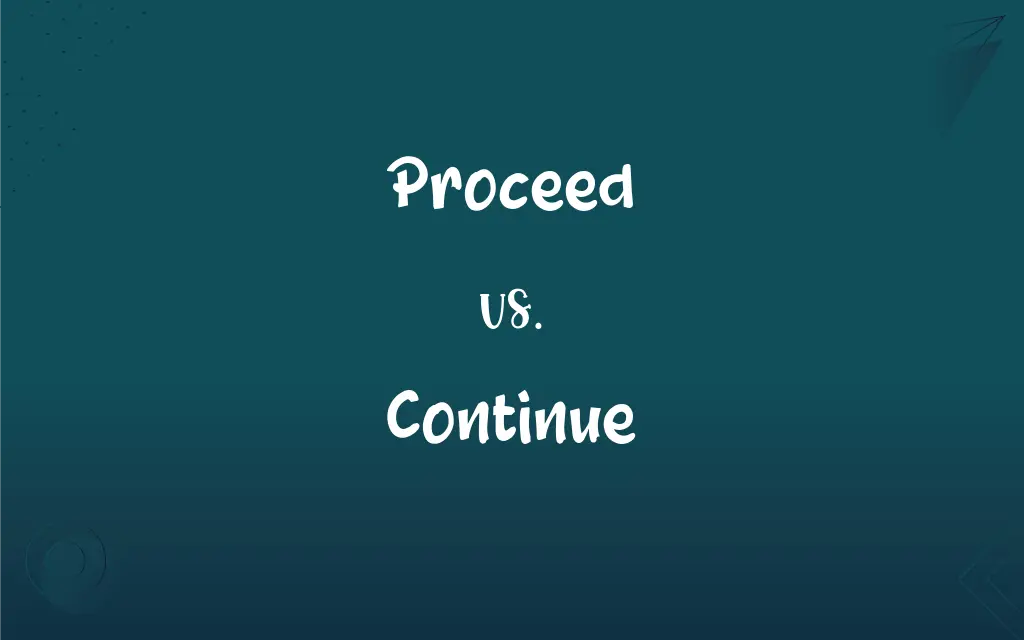Proceed vs. Continue: What's the Difference?
Edited by Harlon Moss || By Janet White || Updated on December 10, 2023
Proceed means to begin or carry on an action or process, while continue means to persist in an ongoing action or process.

Key Differences
Proceed often implies a starting point or moving forward from a specific position or situation, whereas continue refers to maintaining an ongoing action without interruption. Proceed suggests initiation or resumption, while continue emphasizes ongoing action.
Proceed can indicate a transition to a new phase or step, signaling progression, whereas continue implies steady persistence in the same phase or action. Proceed can suggest a forward motion, while continue conveys consistency.
Proceed is often used in formal contexts or instructions, suggesting a more deliberate or planned action, whereas continue is common in everyday language and can imply a more natural or spontaneous action. Proceed may carry a sense of progression, while continue suggests endurance.
Proceed can have a sense of movement or advancement, either physically or metaphorically, while continue often implies remaining on a current course. Proceed can denote moving on to something new, while continue can imply maintaining the status quo.
Proceed is frequently used with prepositions like 'to' or 'with' to indicate a specific direction or action, whereas continue is typically used on its own or with gerunds to indicate the ongoing nature of an activity. Proceed can imply a conscious decision to move forward, while continue suggests an ongoing process.
ADVERTISEMENT
Comparison Chart
Connotation
Initiation or resumption of action
Ongoing or persistent action
Context of Use
Often formal, indicating a planned or deliberate action
Common in everyday language, suggesting natural action
Relation to Action
Transition to a new phase or step
Maintenance of current action or state
Implication of Movement
Suggests forward motion or advancement
Implies staying the course or consistency
Prepositions Used
Common with 'to' or 'with'
Often used alone or with gerunds
ADVERTISEMENT
Temporal Aspect
Starting point or moving forward
Persistence without interruption
Formality Level
Generally more formal
More informal
Suggests Progression
Yes
Not necessarily
Associated with Change
Often indicates a change of phase
Implies continuation of the same phase
Implication of Decision
Suggests a conscious choice to move forward
Indicates an automatic or natural process
Proceed and Continue Definitions
Proceed
To carry out an action or process, especially in a formal context.
The court decided to proceed with the trial.
Continue
To maintain a course of action without interruption.
The marathon runners continued despite the rain.
Proceed
To begin or embark upon an action or process.
The committee will proceed with the meeting after a short break.
Continue
To extend an action or activity further.
The meeting continued well into the evening.
Proceed
To move forward, especially after a pause or delay.
After the roadblock was cleared, the drivers proceeded on their journey.
Continue
To persist in an ongoing action or process.
She continued reading her book despite the noise.
Proceed
To go forward to a new phase or stage.
After the initial research, the team will proceed to the development stage.
Continue
To remain in a state or condition.
The weather is expected to continue cold and dry.
Proceed
To continue after a pause or interruption.
He proceeded with his presentation after the technical issues were resolved.
Continue
To keep doing something without stopping.
He continued working on the project through the weekend.
Proceed
To go forward or onward, especially after an interruption; continue
Proceeded to his destination.
Paused to clear her throat, then proceeded.
Continue
To go on with a particular action or in a particular condition; persist
We continued until the job was finished.
Proceed
To begin to carry on an action or a process
Looked surprised, then proceeded to roar with laughter.
Continue
To exist over a period; last
The meeting continued for another hour.
FAQs
Is proceed used with specific directions?
Yes, proceed is often used with prepositions like 'to' or 'with' indicating a specific direction or action.
Can continue imply beginning something new?
No, continue typically refers to persisting in an ongoing action, not starting a new one.
Is proceed more formal than continue?
Yes, proceed is often more formal and is commonly used in official or planned contexts.
Can continue be used to extend something?
Yes, continue can be used to extend an action or process further than originally planned.
Can continue be used without a direct object?
Yes, continue can be used without a direct object, especially when the context of the ongoing action is understood.
Does proceed imply a conscious decision?
Yes, proceed often implies a conscious decision to begin or move forward in a particular direction.
Can continue be used in a negative context?
Yes, continue can be used in negative contexts, such as continuing a bad habit.
Is proceed used in legal contexts?
Yes, proceed is commonly used in legal and formal contexts to indicate the initiation or continuation of actions.
Does proceed suggest moving to a new phase?
Proceed can suggest advancing to a new phase or stage in a process.
Can proceed and continue be used interchangeably?
While they are similar, they're not always interchangeable as proceed often implies starting or moving forward, and continue implies maintaining an action.
Can continue be used to describe persistence?
Yes, continue is often used to describe persistence in an action, especially in the face of challenges.
Is proceed appropriate for describing physical movement?
Yes, proceed can describe physical movement, especially in the sense of moving forward or advancing.
Can continue be used in emotional contexts?
Yes, continue can be used in emotional contexts, like continuing to feel a certain way.
Is proceed often used in transportation contexts?
Yes, proceed is commonly used in transportation, such as instructing someone to move forward or continue a journey.
Does proceed require a clear direction or goal?
Proceed often implies a clear direction or goal, especially in formal or planned situations.
Can continue indicate a lack of change?
Yes, continue can imply maintaining the current state or course without change.
Does proceed imply a new beginning?
Proceed can imply a new beginning, especially after a pause or change in circumstances.
Can continue imply endurance?
Yes, continue can imply endurance, especially in challenging situations.
Is proceed often used in instructions?
Yes, proceed is frequently used in instructions, guiding someone to start or move forward with an action.
Can continue reflect consistency?
Yes, continue often reflects consistency or steadiness in an action or process.
About Author
Written by
Janet WhiteJanet White has been an esteemed writer and blogger for Difference Wiki. Holding a Master's degree in Science and Medical Journalism from the prestigious Boston University, she has consistently demonstrated her expertise and passion for her field. When she's not immersed in her work, Janet relishes her time exercising, delving into a good book, and cherishing moments with friends and family.
Edited by
Harlon MossHarlon is a seasoned quality moderator and accomplished content writer for Difference Wiki. An alumnus of the prestigious University of California, he earned his degree in Computer Science. Leveraging his academic background, Harlon brings a meticulous and informed perspective to his work, ensuring content accuracy and excellence.































































